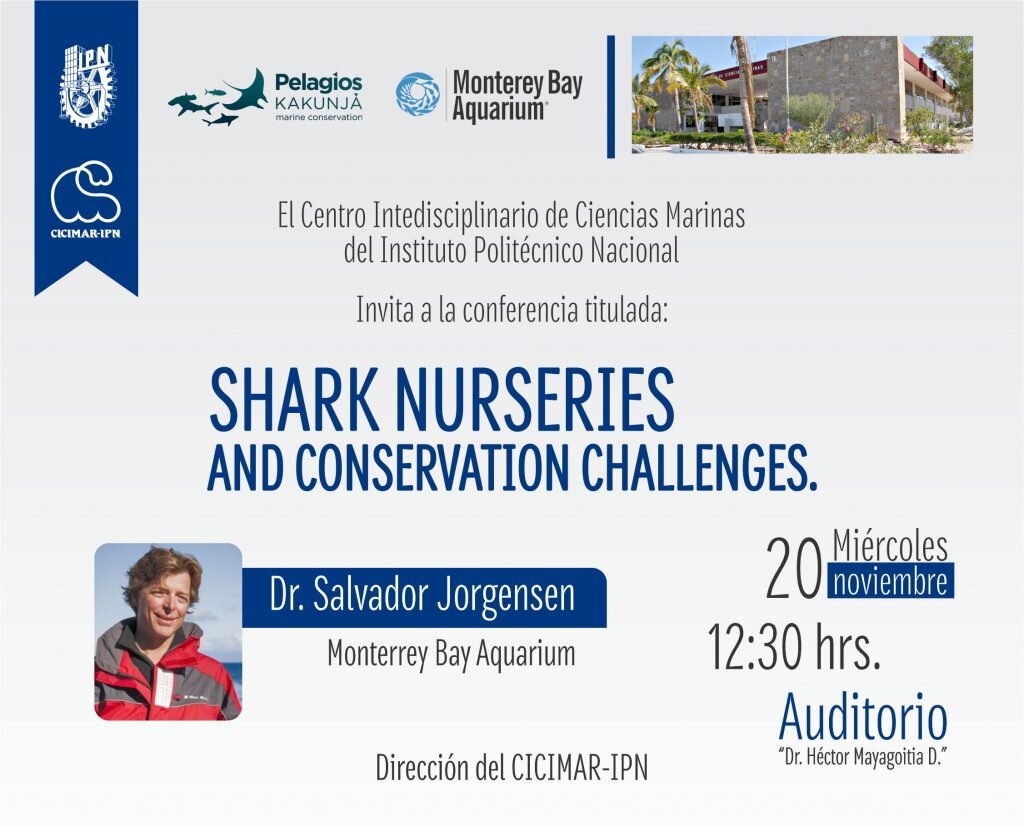Pelagios Kakunjá te invita al ciclo de conferencias del Dr. Salvador Jorgensen
Te invitamos al ciclo de conferencias que impartirá el Dr. Salvador Jorgensen en la ciudad de La Paz, B.C.S. los días miércoles 20 y jueves 21 de noviembre. Las conferencias serán impartidas por el Dr. Jorgensen en tres centros de investigación: Centro Interdisciplinario de Ciencias Marinas-IPN, Centro de Investigaciones Biológicas del Noroeste y Pelagios Kakunjá, A.C. A continuación te compartimos los detalles de cada conferencia:
Shark Nurseries and Conservation Challenges: Miércoles 20 de noviembre, 12:30 hrs., Auditorio “Dr. Héctor Mayagoitia”, CICIMAR-IPN
Abstract: Many shark species reside in distinct habitats during their first months of life known as ‘shark nurseries’. These habitats offer increased shelter and food, where the risk of predation is low and availability of their prey is high. Environmental temperature is also an important factor that may define the location of a shark nursery, as well as the habitat selected within the nursery area. I will describe two case studies of very different scales. One case will consider the large, endothermic white shark (Carcharodon carcharias), and the effect of climate change on the distribution of juveniles along the coast of California and Northern Baja. The second case will consider a shark nursery in the Galapagos archipelago utilized by endangered scalloped hammerhead sharks (Sphyrna lewini). Here we tracked newly-born hammerhead sharks and a second species, black tip reef sharks (Charcharhinus limbatus) that also share this nursery and potentially compete for resources. We describe their habitat preference, daily movement patterns and the degree of overlap between these species of different conservation risk status.
Coastal and pelagic ecology of a top ocean predator: the white shark: Jueves 20 de noviembre, 10:00 hrs., Sala de Seminarios #1, Edif. Anexo de Posgrado, CIBNOR
Abstract: Determining how mobile ocean predators utilize the coastal and pelagic environment is vital to understanding the dynamics of oceanic species and these ecosystems. Northeastern Pacific white sharks (Carcharodon carcharias) are born and grow in coastal waters of California and Baja California, Mexico. Once mature, they migrate seasonally to an oligotrophic region of the Pacific Gyre half way between Baja and Hawaii. The purpose of this annual congregation, for foraging or reproduction, remains unproven. This presentation will cover the unique ecology of this highly migratory, yet philopatric top predator revealed from electronic tagging, genetics, photo identification, and stable isotopic analysis.
Tiburones: mitos y verdades: Jueves de noviembre, 18:00 hrs.,Pelagios Kakunjá
Abstract: Sharks invoke primal fear and fascination like no other predator. White sharks in particular hold a special dark place in our imagination. Public understanding of white sharks has largely been shaped by the literary and cinematic masterpiece JAWS. This narrative has been a barrier to public support for shark conservation. However, recent research using electronic tagging, genetic analysis, records of human interactions, and long-term photo identification is revealing the fascinating hidden life of these majestic predators, and challenging deeply held stereotypes. This presentation will expose some of the ‘fake news’ about sharks, and highlight recent findings that present a new narrative of the predators we love to hate.
El Dr. Salvador Jorgensen es ecólogo marino del Departamento de Investigación y Conservación en el Monterey Bay Aquarium. Sus investigaciones se enfocan en ecología, migración y dinámicas poblacionales de peces pelágicos y elasmobranquios. Ha realizado investigaciones en diferentes ecosistemas, desde bosques de kelp, hasta montañas submarinas y el mar abierto. Jorgensen es licenciado por la Universidad Estatal de Sonoma y Doctor en Ecología por la Universidad de California, Davis, donde trabajó en el diseño de Áreas Marinas Protegidas en California, bajo la ley de Protección de vida Marina de California (MLPA). Durante su doctorado, Jorgensen fue becario Fulbright en Baja California Sur, México, donde estudió los procesos ecológicos de ensamblaje de peces en montañas submarinas someras, y el uso de hábitat profundo hipóxico de tiburón martillo, en colaboración con el CIBNOR y CICIMAR. Jorgensen obtuvo una beca posdoctoral en la Universidad de Stanford, donde se convirtió en el primer miembro del programa de Marcaje de Depredadores del Pacífico (Tagging of Pacific Predators–TOPP), investigador principal de ecología y marcaje de tiburón blanco. Durante la última década, el Dr. Jorgensen ha continuado su trabajo con tiburón blanco y otras especies de tiburones y rayas alrededor del mundo.
Blog publication date: November 19, 2019





